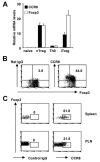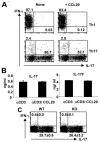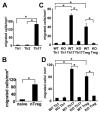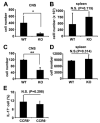CCR6 regulates the migration of inflammatory and regulatory T cells
- PMID: 19050256
- PMCID: PMC2752441
- DOI: 10.4049/jimmunol.181.12.8391
CCR6 regulates the migration of inflammatory and regulatory T cells
Abstract
Th17 and regulatory T (Treg) cells play opposite roles in autoimmune diseases. However, the mechanisms underlying their proper migration to inflammatory tissues are unclear. In this study, we report that these two T cell subsets both express CCR6. CCR6 expression in Th17 cells is regulated by TGF-beta and requires two nuclear receptors, RORalpha and RORgamma. Th17 cells also express the CCR6 ligand CCL20, which is induced synergistically by TGF-beta and IL-6, which requires STAT3, RORgamma and IL-21. Th17 cells, by producing CCL20, promote migration of Th17 and Treg cells in vitro in a CCR6-dependent manner. Lack of CCR6 in Th17 cells reduces the severity of experimental autoimmune encephalomyelitis and Th17 and Treg recruitment into inflammatory tissues. Similarly, CCR6 on Treg cells is also important for their recruitment into inflammatory tissues. Our data indicate an important role of CCR6 in Treg and Th17 cell migration.
Conflict of interest statement
Figures








References
-
- Glimcher LH, Murphy KM. Lineage commitment in the immune system: the T helper lymphocyte grows up. Genes Dev. 2000;14:1693–1711. - PubMed
-
- Dong C, Flavell RA. Th1 and Th2 cells. Curr Opin Hematol. 2001;8:47–51. - PubMed
-
- Harrington LE, Hatton RD, Mangan PR, Turner H, Murphy TL, Murphy KM, Weaver CT. Interleukin 17-producing CD4+ effector T cells develop via a lineage distinct from the T helper type 1 and 2 lineages. Nat Immunol. 2005;6:1123–1132. - PubMed
Publication types
MeSH terms
Substances
Grants and funding
LinkOut - more resources
Full Text Sources
Other Literature Sources
Molecular Biology Databases
Miscellaneous

